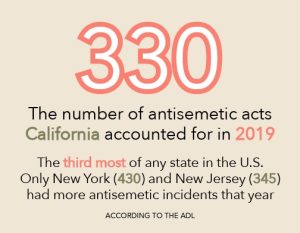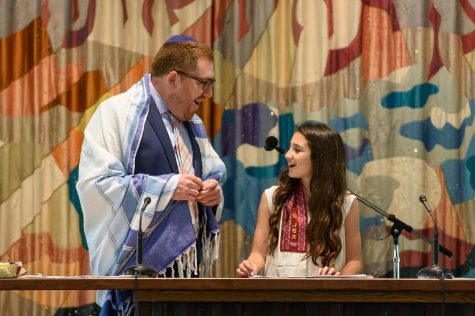Jewish community members urge alliance to battle antisemitism
December 3, 2021
“No one is born with hate,” said Michelle Dorfman (11), whose great-grandfather passed away in the Holocaust. “It’s something that you’re taught. So the more we become educated about a topic, the [smaller] the possibility of having prejudice against that.”
Since 1979, the United States experienced the highest number of antisemitic incidents in 2019, with more than 2,100 acts of assault, vandalism and harassment reported by the Anti-Defamation League (ADL), a 12% increase from the 1,879 incidents recorded in 2018. On average, six antisemitic acts occurred each day, while there also was a 56% increase in assaults.

The ADL provides the following definition for antisemitism: “the belief or behavior hostile toward Jews just because they are Jewish. It may take the form of religious teachings that proclaim the inferiority of Jews, for instance, or political efforts to isolate, oppress or otherwise injure them. It may also include prejudiced or stereotyped views about Jews.”
California, as of 2017, holds a Jewish population of approximately 1,230,540. In 2019, California accounted for 330 antisemitic acts, placing it among the states with the highest numbers of incidents along with 430 in New York, 345 in New Jersey, 114 in Massachusetts and 109 in Pennsylvania, according to the ADL. These states combined account for nearly 45% of the total number of incidents.
After looking at the survey results and comparing it to widespread antisemitism today, Michelle says that it is “important to acknowledge that while [many] Jews are white-passing, they still receive heavy discrimination,” making an effort to expose the significance of the Holocaust today amongst herself and her peers.
“To me, the Holocaust is a historical symbol of hate towards the Jewish community and how people were able to weaponize that hate to commit mass genocide,” Michelle said. “Since I’ve been brought up in very privileged communities, antisemitism towards me isn’t in the form of violence but more in words and pictures. I’ve seen Swastikas drawn on bathroom stalls, and people have said stupid things to me like ‘have you killed Christ’ or something like that.”
Comparing her own experience in the states to her parents, though, Michelle reflects on how her father’s was much more severe. In fact, Michelle’s father had to change his last name to escape prejudice and hide his Jewish ethnicity when he was brought up in Russia, and only when he immigrated to America did he decide to change his last name back.
Amongst the youth demographic, educational institutions also continue to experience widespread antisemitism. The ADL continues that non-Jewish K-12 schools experienced 411 antisemitic incidents in 2019, a 19% increase from the 344 incidents reported in 2018, and 186 incidents at colleges and universities.
“Even beyond just that person-to-person interaction is this bigger person-to-institution interaction. Take something like the College Board,” Yusupov said. “There is no checkbox for Jewish people, who have been actively oppressed for years and years. You’re labeled as just Caucasian or white or of European descent, or if you’re from Israel, you’re of Middle Eastern descent.”
In fact, Yusupov’s frustration is also directed at a common myth that Jewish people do not experience oppression, simply because they are labeled as white. She believes that national educational institutions such as the College Board can make a greater effort to include the Jewish population to create exposure and recognition for the ethnicity.
“It fails to consider this entire category of people, and that sits very uneasy with me,” Yusupov said. “When someone else looks at me, they say, ‘You’re a white girl, you haven’t been oppressed.’ But half my family died in the Holocaust. This is overlooked in the way that systemic racism that applies to Jewish people is overlooked. To me, that is a very, very big problem.”

Zoe Sanders (’21), who identifies as Reform Jewish, first experienced antisemitism in middle school at the Blackford campus, when one of her friends made an “offhanded” joke about the Holocaust. She felt unsure about how to respond, torn between defending an event significant to her Jewish heritage and maintaining a loose atmosphere around a “joke.”
As she grew older, absorbing more information and becoming more aware of her culture’s history, Sanders often thought back to her middle school interaction. From Sanders’ first synagogue from when she lived in Florida — Temple Dor Dorim — to her current synagogue in Los Altos Hills, California — Congregation Beth Am — Sanders has found a wide array of Jewish community members to learn from and rely on.
“It’s important to me that people recognize the Holocaust,” Sanders said. “As I grew older, I began to connect more with my Jewish roots such as through volunteering at Jewish programs and working with kids who didn’t know as much like I once did, and I found more confidence in speaking up when things that were being said weren’t okay to say.”
At Congregation Beth Am, Sanders met Rabbi Jonathan Prosnit, who was an influential figure in learning more about the Holocaust. Rabbi Prosnit recognizes the value of education in combating antisemitism, such as hearing firsthand from survivors, reading primary documents or even visiting the United States Holocaust Memorial Museum in Washington D.C. Some organizations that Prosnit recommends those seeking to find allies or educate themselves more on the Holocaust are Yad Vashem, The World Holocaust Remembrance Center, the Jewish Community Relations Council (JCRC) and the Anti-Defamation League (ADL).
“Antisemitism is a real thing,” Rabbi Prosnit said. “As Jews, we can’t let any hate metastasize. We can’t let jokes, slights, small comments live.”
At the upper school, Pianko notes that antisemitism should be treated in the same way as hate directed toward other marginalized groups — with intolerance. She believes that creating a culture that rejects antisemitism rather than mitigating the effects of discrimination is key to fighting the problem.
“Antisemitism never goes away. It just sometimes falls dormant until it wakes up again. That hatred is just always there,” Pianko said. “Education, engaging with people, understanding this cycle, it’s the only way that people will truly believe that we have a problem and that we need to break this cycle. Antisemitism is something that is happening in our world today, and there’s been an increase. If we want to battle this thing, then we need to know what this thing is.”
An abridged version of this article was originally published in Volume 23, Issue 2 of The Winged Post. On Nov. 13, 2021, this article was awarded 5th place for Social Justice Reporting in the 2021 NSPA Best of Show Award Individual Recognition competition.